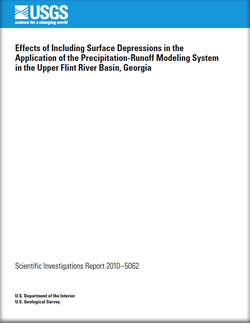Scientific Investigations Report 2010–5062

This report documents an extension of the Precipitation Runoff Modeling System that accounts for the effect of a large number of water-holding depressions in the land surface on the hydrologic response of a basin. Several techniques for developing the inputs needed by this extension also are presented. These techniques include the delineation of the surface depressions, the generation of volume estimates for the surface depressions, and the derivation of model parameters required to describe these surface depressions. This extension is valuable for applications in basins where surface depressions are too small or numerous to conveniently model as discrete spatial units, but where the aggregated storage capacity of these units is large enough to have a substantial effect on streamflow. In addition, this report documents several new model concepts that were evaluated in conjunction with the depression storage functionality, including: “hydrologically effective” imperviousness, rates of hydraulic conductivity, and daily streamflow routing. All of these techniques are demonstrated as part of an application in the Upper Flint River Basin, Georgia. Simulated solar radiation, potential evapotranspiration, and water balances match observations well, with small errors for the first two simulated data in June and August because of differences in temperatures from the calibration and evaluation periods for those months. Daily runoff simulations show increasing accuracy with streamflow and a good fit overall. Including surface depression storage in the model has the effect of decreasing daily streamflow for all but the lowest flow values. The report discusses the choices and resultant effects involved in delineating and parameterizing these features. The remaining enhancements to the model and its application provide a more realistic description of basin geography and hydrology that serve to constrain the calibration process to more physically realistic parameter values. |
First posted August 4, 2010 For additional information contact: Part or all of this report is presented in Portable Document Format (PDF); the latest version of Adobe Reader or similar software is required to view it. Download the latest version of Adobe Reader, free of charge. |
Viger, R.J., Hay, L.E., Jones, J.W., and Buell, G.R., 2010, Effects of including surface depressions in the application of the Precipitation-Runoff Modeling System in the Upper Flint River Basin, Georgia: U.S. Geological Survey Scientific Investigations Report 2010–5062, 36 p.
Abstract
Introduction
Previous Studies
Model Conceptualization and Parameterization
Precipitation-Runoff Modeling System Input Data Sets
General Procedure for Calibration of the Precipitation-Runoff Modeling System
Details of Precipitation-Runoff Modeling System Calibration in the Upper Flint River Basin
Effects of Including Surface Depressions in Modeling Process
Model Limitations
Conclusions
References Cited